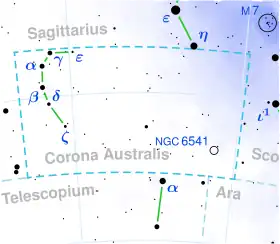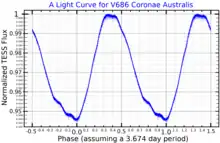 | |
| Observation data Epoch J2000.0 Equinox J2000.0 (ICRS) | |
|---|---|
| Constellation | Corona Australis |
| Right ascension | 18h 56m 40.48593s[1] |
| Declination | −37° 20′ 35.7013″[1] |
| Apparent magnitude (V) | 5.25 to 5.41[2] |
| Characteristics | |
| Evolutionary stage | main sequence star[3] |
| Spectral type | B3V[4] |
| U−B color index | −0.70[5] |
| B−V color index | −0.15[5] |
| Variable type | α2 CVn[2] |
| Astrometry | |
| Radial velocity (Rv) | 1.3±0.8[6] km/s |
| Proper motion (μ) | RA: +8.747 mas/yr[1] Dec.: −25.654 mas/yr[1] |
| Parallax (π) | 6.8427 ± 0.1921 mas[1] |
| Distance | 480 ± 10 ly (146 ± 4 pc) |
| Absolute magnitude (MV) | −0.24[7] |
| Absolute bolometric magnitude (Mbol) | −1.9[8] |
| Details | |
| Mass | 4.73±0.21[9] M☉ |
| Radius | 3.52±0.18[10] R☉ |
| Luminosity | 504+42 −39[3] L☉ |
| Surface gravity (log g) | 3.97[8] cgs |
| Temperature | 16,482+501 −486[11] K |
| Metallicity [Fe/H] | +1.13[12] dex |
| Rotational velocity (v sin i) | 45.4±5.1[13] km/s |
| Age | 63[8] Myr |
| Other designations | |
| Database references | |
| SIMBAD | data |
V686 Coronae Australis (HD 175362; HR 7129; V686 CrA) is a solitary, bluish-white-hued variable star located in the southern constellation Corona Australis. It has an apparent magnitude that ranges between 5.25 and 5.41,[2] which makes it faintly visible to the naked eye. Gaia DR3 parallax measurements imply a distance of 480 light years[1] and it is slowly receding with a heliocentric radial velocity of 1.3 km/s.[6] At its current distance V686 CrA's average brightness is diminished by 0.35 magnitudes due to extinction from interstellar dust[16] and it has an absolute visual magnitude of −0.24. [7]
V686 CrA has been known to be variable since 1974. The discovery paper lists it as a helium variable with a period of 3.71 days.[17] Earlier sources give it ordinary spectral classes such as B7.5 V, B8 IV. and B9 III:. [18][19][20] In 1976, V686 CrA was found to have a large magnetic field ranging from −5,000 gauss to 7,000 gauss.[21] Borra et al. (1983) gave a value of −6,500–4,800 gauss.[22] A catalogue of chemically peculiar stars gives a spectral class of B6 He wk. Si, indicating it is a helium-weak star.[23] It has also been classified as a mercury-manganese star.[24]

V686 CrA is an α2 Canum Venaticorum variable that ranges from 5.25 to 5.41[2] within 3.674 days.[26][27] It has been proposed that the rotation period of the star, and hence the true variability period, is 7.34 days, with two near-identical minima in the light curve.[28] It is a member of the Scorpius-Centaurus association and the Local Association.[29]
The accepted stellar classification for V686 CrA is B3V,[15] indicating that it is B-type main sequence star. It has 4.73 times the mass of the Sun[9] and 3.52 times the Sun's radius.[10] It radiates 504 times the luminosity of the Sun[3] from its photosphere at an effective temperature of 16,482 K[11] V686 has an unusually high metallicity of [Fe/H] = +1.13,[12] which is over 10 times that of the sun. This only accounts for the spectrum of the star and not its entire composition. Like most chemically peculiar stars it spins rather slowly, having a projected rotational velocity of 45.4 km/s.[13] Based on analysis of its surface magnetic fields, V686 CrA is estimated to be 63 million years old,[8] although other sources give a much younger age: for example, 7.9 million years[30] having completed only 0.9% of its main sequence lifetime.[3]
References
- 1 2 3 4 5 6 Vallenari, A.; et al. (Gaia collaboration) (2023). "Gaia Data Release 3. Summary of the content and survey properties". Astronomy and Astrophysics. 674: A1. arXiv:2208.00211. Bibcode:2023A&A...674A...1G. doi:10.1051/0004-6361/202243940. S2CID 244398875. Gaia DR3 record for this source at VizieR.
- 1 2 3 4 Samus’, N. N.; Kazarovets, E. V.; Durlevich, O. V.; Kireeva, N. N.; Pastukhova, E. N. (January 2017). "General catalogue of variable stars: Version GCVS 5.1". Astronomy Reports. 61 (1): 80–88. Bibcode:2017ARep...61...80S. doi:10.1134/S1063772917010085. eISSN 1562-6881. ISSN 1063-7729. S2CID 125853869.
- 1 2 3 4 Zorec, J.; Royer, F. (January 2012). "Rotational velocities of A-type stars IV: Evolution of rotational velocities". Astronomy & Astrophysics. 537: A120. arXiv:1201.2052. Bibcode:2012A&A...537A.120Z. doi:10.1051/0004-6361/201117691. eISSN 1432-0746. ISSN 0004-6361. S2CID 55586789.
- ↑ Houk, N. (1982). Michigan Catalogue of Two-dimensional Spectral Types for the HD stars. Volume_3. Declinations -40_ƒ0 to -26_ƒ0. Bibcode:1982mcts.book.....H.
- 1 2 Gutierrez-Moreno, Adelina; Moreno, Hugo (June 1968). "A Photometric Investigation of the SCORPlO-CENTAURUS Association". The Astrophysical Journal Supplement Series. 15: 459. Bibcode:1968ApJS...15..459G. doi:10.1086/190168. eISSN 1538-4365. ISSN 0067-0049. S2CID 123957668.
- 1 2 Gontcharov, G. A. (November 2006). "Pulkovo Compilation of Radial Velocities for 35,495 Hipparcos stars in a common system". Astronomy Letters. 32 (11): 759–771. arXiv:1606.08053. Bibcode:2006AstL...32..759G. doi:10.1134/S1063773706110065. eISSN 1562-6873. ISSN 1063-7737. S2CID 119231169.
- 1 2 Anderson, E.; Francis, Ch. (May 2012). "XHIP: An extended hipparcos compilation". Astronomy Letters. 38 (5): 331–346. arXiv:1108.4971. Bibcode:2012AstL...38..331A. doi:10.1134/S1063773712050015. eISSN 1562-6873. ISSN 1063-7737. S2CID 119257644.
- 1 2 3 4 Glagolevskij, Yu. V. (January 2019). "On Properties of Main Sequence Magnetic Stars". Astrophysical Bulletin. 74 (1): 66–79. Bibcode:2019AstBu..74...66G. doi:10.1134/S1990341319010073. eISSN 1990-3421. ISSN 1990-3413. S2CID 149900274.
- 1 2 Netopil, Martin; Paunzen, Ernst; Hümmerich, Stefan; Bernhard, Klaus (17 March 2017). "An investigation of the rotational properties of magnetic chemically peculiar stars". Monthly Notices of the Royal Astronomical Society. 468 (3): 2745–2756. arXiv:1703.05218. Bibcode:2017MNRAS.468.2745N. doi:10.1093/mnras/stx674. eISSN 1365-2966. ISSN 0035-8711. S2CID 119215348.
- 1 2 Kervella, P.; Thévenin, F.; Di Folco, E.; Ségransan, D. (October 2004). "The angular sizes of dwarf stars and subgiants. Surface brightness relations calibrated by interferometry". Astronomy & Astrophysics. 426 (1): 297–307. arXiv:astro-ph/0404180. Bibcode:2004A&A...426..297K. doi:10.1051/0004-6361:20035930. eISSN 1432-0746. ISSN 0004-6361. S2CID 6077801.
- 1 2 Kochukhov, O.; Bagnulo, S. (10 April 2006). "Evolutionary state of magnetic chemically peculiar stars". Astronomy and Astrophysics. 450 (2): 763–775. arXiv:astro-ph/0601461. Bibcode:2006A&A...450..763K. doi:10.1051/0004-6361:20054596. eISSN 1432-0746. ISSN 0004-6361. S2CID 18596834.
- 1 2 Leone, F.; Manfre, M. (April 1997). "The importance of a correct abundance assumption in determining the effective temperature and gravity of stars. A spectroscopic study of the helium weak stars HD 5737, HD 175362 and HD 202671". Astronomy and Astrophysics. 320: 257–264. Bibcode:1997A&A...320..257L. ISSN 0004-6361. S2CID 15338856.
- 1 2 Mathys, G. (19 December 1994). "Spectropolarimetry of magnetic stars. V. The mean quadratic magnetic field". Astronomy and Astrophysics. 293: 746–763. Bibcode:1995A&A...293..746M. ISSN 0004-6361. S2CID 115390944.
- ↑ Gould, Benjamin Apthorp (1878). "Uranometria Argentina : brillantez y posicion de las estrellas fijas, hasta la septima magnitud, comprendidas dentro de cien grados del polo austral : con atlas". Resultados del Observatorio Nacional Argentino. 1. Bibcode:1879RNAO....1.....G.
- 1 2 "V686 CrA". SIMBAD. Centre de données astronomiques de Strasbourg. Retrieved March 8, 2023.
- ↑ Gontcharov, George A.; Mosenkov, Aleksandr V. (28 September 2017). "Verifying reddening and extinction for Gaia DR1 TGAS main sequence stars". Monthly Notices of the Royal Astronomical Society. 472 (4): 3805–3820. arXiv:1709.01160. Bibcode:2017MNRAS.472.3805G. doi:10.1093/mnras/stx2219. eISSN 1365-2966. ISSN 0035-8711. S2CID 118879856.
- ↑ Balona, L.; Martin, W. L. (1 January 1974). "A New Helium Variable". Monthly Notices of the Royal Astronomical Society. 166 (1): 35P–38P. Bibcode:1974MNRAS.166P..35B. doi:10.1093/mnras/166.1.35P. eISSN 1365-2966. ISSN 0035-8711. S2CID 121375376.
- ↑ Hoffleit, Dorrit (July 1956). "Distances for Southern Early-Type Stars, Especially in Carina and Other H II Regions". The Astrophysical Journal. 124: 61. Bibcode:1956ApJ...124...61H. doi:10.1086/146203. eISSN 1538-4357. ISSN 0004-637X. S2CID 121653320.
- ↑ de Vaucouleurs, A. (1 August 1957). "Spectral Types and Luminosities of B, A and F Southern Stars". Monthly Notices of the Royal Astronomical Society. 117 (4): 449–462. Bibcode:1957MNRAS.117..449D. doi:10.1093/mnras/117.4.449. eISSN 1365-2966. ISSN 0035-8711. S2CID 121925254.
- ↑ Feast, M. W.; Thackeray, A. D.; Wesselink, A. J. (1957). "Radial velocities of southern B stars determined at the Radcliffe Observatory Part II". Memoirs of the Royal Astronomical Society. 68: 1–35. Bibcode:1957MmRAS..68....1F. ISSN 0369-1829.
- ↑ Wolff, R. J.; Wolff, S. C. (January 1976). "HR 7129 - A helium variable with a large magnetic field". The Astrophysical Journal. 203: 171. Bibcode:1976ApJ...203..171W. doi:10.1086/154060. eISSN 1538-4357. ISSN 0004-637X. S2CID 122861117.
- ↑ Borra, E. F.; Landstreet, J. D.; Thompson, I. (September 1983). "The magnetic fields of the helium-weak B stars". The Astrophysical Journal Supplement Series. 53: 151. Bibcode:1983ApJS...53..151B. doi:10.1086/190889. eISSN 1538-4365. ISSN 0067-0049. S2CID 121238583.
- ↑ Renson, P.; Manfroid, J. (May 2009). "Catalogue of Ap, HgMn and Am stars". Astronomy and Astrophysics. 498 (3): 961–966. Bibcode:2009A&A...498..961R. doi:10.1051/0004-6361/200810788.
- ↑ Cucchiaro, A.; et al. (October 1977). "Spectral classification from the ultraviolet line features of S2/68 spectra. II - Late B-type stars". Astronomy and Astrophysics Supplement Series. 30: 71–79. Bibcode:1977A&AS...30...71C.
- ↑ "MAST: Barbara A. Mikulski Archive for Space Telescopes". Space Telescope Science Institute. Retrieved 13 March 2023.
- ↑ Waelkens, C. (July 1985). "Photometric variations and period determination of eight southern CP stars". Astronomy and Astrophysics Supplement Series. 61: 127–139. Bibcode:1985A&AS...61..127W.
- ↑ Lefèvre, L.; Marchenko, S. V.; Moffat, A. F. J.; Acker, A. (November 2009). "A systematic study of variability among OB-stars based on HIPPARCOS photometry". Astronomy and Astrophysics. 507 (2): 1141–1201. Bibcode:2009A&A...507.1141L. doi:10.1051/0004-6361/200912304.
- ↑ Balona, L. A. (1975). "The helium variable HR 7129". Monthly Notices of the Royal Astronomical Society. 173 (3): 605. Bibcode:1975MNRAS.173..605B. doi:10.1093/mnras/173.3.605.
- ↑ Eggen, Olin J. (September 1998). "The Scorpius OB2 Complex". The Astronomical Journal. 116 (3): 1314–1322. Bibcode:1998AJ....116.1314E. doi:10.1086/300491. ISSN 0004-6256. S2CID 120161033.
- ↑ Tetzlaff, N.; Neuhäuser, R.; Hohle, M. M. (January 2011). "A catalogue of young runaway Hipparcos stars within 3 kpc from the Sun". Monthly Notices of the Royal Astronomical Society. 410 (1): 190–200. arXiv:1007.4883. Bibcode:2011MNRAS.410..190T. doi:10.1111/j.1365-2966.2010.17434.x. S2CID 118629873.